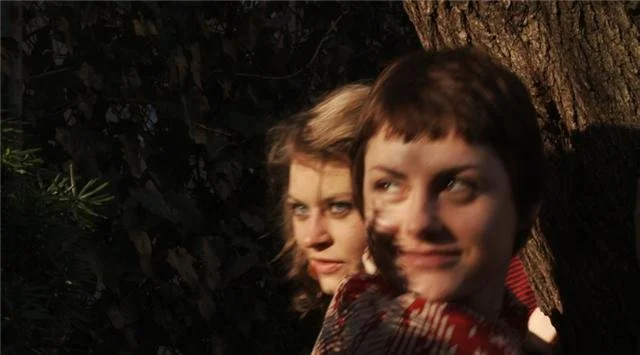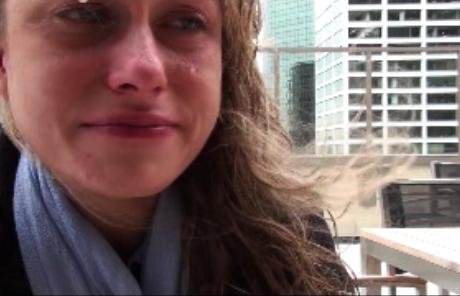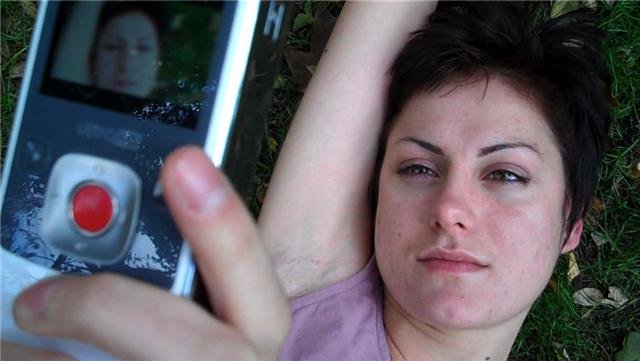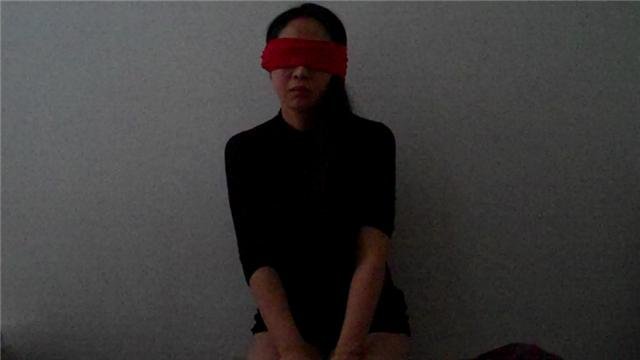revolution of everyday life
trailer
full film
Two young women meet in an explosive and highly emotional love story where love, art and revolution ignite.
In this film 9 women record themselves being alone. At times they get together as an experimental arts collective hotly debating the value of their private work and whether to do public performances. Two of them fall in love. One becomes obsessed with the other and simultaneously imagines an idealized love while the other wants her to find the revolutionary part of herself. Revolution of Everyday Life is a document of actresses playing actresses who play characters that fall in love. It is at the same time a love story that happens in the realm of fiction and in the realm of recorded reality. The result is a documentary film within a fictional one. The film becomes a site not for representation but discovery. It is a structure for things to happen, it becomes the site for performing, not acting, not re-presenting desire, but to enact it - it is a longing for politic of desire and an expression of its urgency.
REVIEWS / ESSAYS
"The banker, the revolutionary, performance and reality, youth in search of a politic, all the contemporary conversations and confusions about love, money, friendship, it's all here, very smart..."
Todd Stevens, producer, Friends
“Raw, real and beautiful.”
T.G. Herrington, editor, The Mechanic
“...an amazing character study... while watching this film, one can not look away...the main character's face followed my thoughts for days after...”
Nestor Gonzales, film curator
Cinema of the Event: On Marc Lafia’s Revolution of Everyday Life
Daniel Coffeen 09.23.10
Cinema is no longer monumental. Despite the best efforts of Hollywood, making a film no longer demands millions of dollars, booms, grips, lights, and cameras. We don’t need theaters. We don’t need studios. All we need is a mobile phone. Cinema has become everyday.
Marc Lafia has taken to making films that embrace the everyday cinema machine. He has an idea; puts together a cast (he has started working with the same actors); and films on the streets of New York with digital cameras. In his latest, 'Revolution of Everyday Life', he gives HD Flip video cameras to the cast and has them film themselves alone.
For Lafia, this process is not an inexpensive way to make a so-called indie film with its quirky characters and narratives of redemption. This is not mumblecore. Nor is it ‘The Blair Witch Project’ or ‘Mean Streets.’ For Lafia, the everyday tools of cinema breed an emergent cinema, a cinema of the event, in which the very act of recording creates something new.
The camera in this digital age — and in the hands of Lafia — is not a means of mediating an encounter. On the contrary, the camera forges the encounter. The camera here is not as much a recording device per se as it is what Burroughs and Gysin call the Third Mind — an active perceptive engine that functions between and amongst all participants, that thrives in the very event of seeing and being seen.
Throughout ‘Revolution of Everyday Life,’ we encounter scenes — or, better, we encounter encounters — that have only come into being because the camera was present. We see sense emerging. We see faces and people and love and the social emerge not just in front of the camera but with the camera. In the exquisite scenes of the women alone recording themselves — scenes that are private, exhuming, creative, peculiar — we come to understand that the camera is a presence, a kind of face that grasps and inspires. The recording event — which, in this digital world, is a playback event, as well — does not just record: it creates events.
‘Revolution of Everyday Life’ reckons the very nature, the possibility, of this cinematic event. Look at the achingly gorgeous scene of Lizzie alone with her camera, filming herself in the mirror. There is a breathtaking intimacy here, an intimacy that would be impossible without the camera, that could never happen without the act of recording. The film then cuts to Tjasa standing on the street, a dildo strapped to her skirt, haranguing passers by.
The film seems, then, to move from the private to the public. But this distinction is false. After all, the so-called private scene of Lizzie is not just a recording but a broadcasting, her room and tears and body on display. In fact, rather than reifying a public-private dichotomy, ‘The Revolution of Everyday Life’ works to erase it. The boundary that would keep our private and public worlds distinct has been superseded by the pervasive cinema engine.
The distinction the film draws is not between public and private but between demanding to be seen and allowing oneself to be seen. On the one hand, there’s Tjasa who imagines herself a radical fomenting change through situationist performances. Tjasa demands to be seen, screeching into the camera just as she screeches at others, to no one and everyone. Meanwhile, Lizzie, her lover, avoids the spotlight but finds a much more intimate relationship with the camera and with being seen. In a gesture of infinite generosity, she allows herself to be seen.
This is not simply a dichotomy of real events vs. recorded events, the street vs. the bedroom the public vs. the private. Both events are recorded; both events are image, are cinema. No, in these two modes we get postures of standing towards perception, postures of being seen. We get an ethics (mercifully bereft of judgment).
But ‘Revolution of Everyday Life’ is not about the cinema event. It is a cinema event. The process of making the film and the film are so thoroughly intertwined it is often difficult to distinguish one from the other. But not through reflexivity — we don’t see booms entering the frame. Rather, we encounter a film in the process of making itself, characters in the process of making themselves to a point where we’re not even sure if they are characters. They exist in a state of person-becoming, character-becoming, actor-becoming just as the film flourishes in the space of cinema-becoming. Events are at once real and not, recorded and live simultaneously.
‘Revolution of Everyday Life’ hence breaks down the rigid lines that separate creation from playback, writing from reading, and finally subject from object. The pervasive cinema engine, the everyday cinema engine, not only rewrites cinema: it rewrites the private and the social, the very manner in which we present and are presented to the world.
In the contemporary world of pervasive cinema, we present ourselves as something to be seen, something always already seen, always already being seen. And yet we do so without evacuating our individuality. We are turned inside out, splayed, but not eviscerated. On the contrary, we are multiplied, extended, disseminated, and proliferated.
And this, alas, foments the revolution of everyday life. The title is taken from the English translation of Raoul Vaneigem’s great situationist treatise by the same title. The revolution, then, is not Tjasa’s ranting against capitalism. Nor is it her all-too-familiar spectacles of S&M. The revolution of everyday life is the proliferation of cinema within and through the everyday.
If we live in a society of the spectacle, this everyday cinema decenters image production, proliferates centers, shatters the hegemony of the corporation’s will to quantity and uniformity. This pervasiveness of cinema — this ability to create, distribute, and screen on demand — fundamentally shifts flows of communication, introducing radical new possibilities of constituting the social. Images no longer solely flow downhill or in a straight linear line. They are no longer solely created by vast corporations and streamed into our houses. Images now flow every which way — up, down, sideways, diagonally — disrupting the painful banality of narrative, character and cliché.
As cinema takes up the everyday, it infuses life and is in turn infused. Engaging this everyday cinema engine, Lafia gives us a living cinema, a live cinema, a cinema that is always (and already) in the process of making itself, a cinema replete with affect, with the impossible complexity of the human: a cinema that is revolutionary.
Revolution of Everyday Life
Description Longer
Two young women meet in an explosive and highly emotional love story where love, art and revolution ignite. Lizzy a young student works arranging cans in a delicatessen in little Odessa, New York. She dreams of art and being a well known actress. One day after an audition at an atm machine a fawn intoxicates her with a spell. Soon Lizzy is looking into a perfume store where she is enchanted by a woman who calls her self, Tjasa and the two fall wildly in love.Tjasa, an artist actor revolutionary brings Lizzy to her performance group, all of whom are recording small private actions looking first to change themselves, but Tjasa challenges them to take it to the streets to turn the private into the public to shout, enough whispers. This begins a tension and they all argue how really to change and make a better world Tjasa takes Lizzy onto the streets of new york, to super markets, cafes, wall street, public squares; with each place they do situationist actions to change perceptions of the everyday, for themselves and others. All along Lizzy sees in Tjasa a magical, inspiring firebrand and for the first time in her life awakens to life’s possibilities. They make love. take vows to celebrate their mythic and present femininity, falling more deeply attached as Tjasa’s cleans Lizzy’s heart and makes it new. Though Tjasa loves love she sees life, art and revolution as love and more than worldly love and material relationships. When the group meets to talk of future actions they reject Tjasa’s forceful approach questioning the change made by such actions. Tjasa we’ve learned is prepared to change life, affirm life with art or with a weapon as she tries to physically evict a landlord from her table at Borders before security stops her. In a climatic scene where one of the members of the group is whipped in public by Tjasa, turning the others disapprovingly away from her, Lizzy joins the group and there disavowal. For Tjasa, love, acting, self-pity is all much too bourgeoisie for and so she affirms her self and those few left by taking her red feathers and letting them take flight onto Saint Marks Square bringing joy to people. in solitude and reflection Lizzy looks back to the beauty the two of them had and what she has now lost. There are some spirits in the world that refuse to be tamed.
Becoming Recordings
Revolution of Everyday Life flowered from a desire to make a film called 69lovestories. The title was inspired by the 3 disc album 69love songs by the Magnetic Fields, an extraordinarily beautiful group of recordings, you might say we made 1 love song, revolution, and so here at this site we want to carry on with the ideas of repetition and difference that informed Raymond Queneau’s, Exercises in Style, and 69 love stories and create a conversation, a set of instructions about ideas of revolution, a new way to think about recording and film as something global and conversational, as a dialogue. the actions here are the first of 69 that we hope to do over the next year and grow this site and involve you…
The revolution site presents the film and extends all that informs it, with a desire to share and contextualize it, to have others perform and repeat it.

























